Contents
[Introduction] [Stratigraphical and sedimentological settings ...]
[Pore filling versus residual porosity]
[Record of tectonic events] [Relations to chronology of field "X"]
[Conclusions] [Bibliographic references] and ... [Figures]
Université Européenne de Bretagne, Brest (France);
Université de Brest; CNRS; IUEM; Domaines Océaniques UMR 6538, 6 Avenue Le
Gorgeu, CS 93837, F-29238 Brest Cedex 3 (France);
postal address: Département des Sciences de la Terre et de l'Univers,
UFR des Sciences et Techniques, Université de Bretagne Occidentale (UBO), 6 avenue Le
Gorgeu - CS 93837, F-29238 Brest Cedex 3 (France)
CORIAS, 74 Allée de la Robertsau, F-67000 Strasbourg (France)
Manuscript online since September 30, 2009
Cathodoluminescence analyses on samples from Middle Jurassic oolitic limestones allow us to reconstruct the diagenetic history of these oil and gas reservoirs: a succession of events starting with the early, synsedimentary phases of marine cementation and ending with the addition of hydrocarbons to the reservoir. Constraints on the timing of events are derived from their calibration with the chronology of the well-known regional tectonic calendar. Fracturing, due first to the post-Pyrenean extension and then to the Alpine compression, led respectively in Oligocene times to a recharge of the aquifer and a correlative change in cementation, and in Miocene times to the addition of hydrocarbons into the same flow units, this last event blocking diagenesis, at least in the zone above the oil-water contact. Distributions of cements and residual porosity within sedimentary units without stratigraphic significance, called here "pseudo-parasequences", were for the most part inherited from the original depositional facies.
Cathodoluminescence; Middle Jurassic; Callovian; Paris basin; echinoderms; oolite; ooid; calcitic cement; porosity.
B. & C. (2009).- Quick look cathodoluminescence analyses and their impact on the interpretation of carbonate reservoirs. Case study of mid-Jurassic oolitic reservoirs in the Paris Basin.- Carnets de Géologie / Notebooks on Geology, Brest, Article 2009/07 (CG2009_A07)
Analyses rapides en cathodoluminescence et leur impact dans la compréhension des réservoirs carbonatés. Exemple de réservoirs oolithiques du Jurassique moyen du bassin de Paris.- L'étude d'échantillons de calcaires oolithiques du Jurassique en cathodoluminescence a permis de reconstituer l'histoire diagénétique de ces réservoirs de pétrole et de gaz, c'est-à-dire l'enregistrement d'une succession d'événements débutant avec des phases précoces de cimentation marine, synsédimentaires, et s'achevant avec l'arrivée des hydrocarbures. Par corrélation avec le calendrier tectonique régional, relativement bien connu, ces événements ont pu être calés sur l'échelle stratigraphique. Les phases de fracturation, en relation avec la phase d'extension qui a succédé à la compression post-pyrénéenne, puis avec la compression alpine, ont conduit respectivement à l'Oligocène à recharger l'aquifère et par conséquent à modifier la cimentation, puis au Miocène à y introduire des hydrocarbures, ce dernier événement entraînant un arrêt de la diagenèse, au moins pour l'intervalle situé au-dessus du contact pétrole-eau. La répartition des ciments et celle de la porosité résiduelle au sein d'unités sédimentaires dépourvues de toute valeur stratigraphique, appelées ici "pseudo-paraséquences", sont en grande partie contraintes par le faciès initial de dépôt.
Cathodoluminescence ; Jurassique moyen ; Callovien ; bassin de Paris ; échinodermEs ; oolithe ; ooïde ; ciment calcitique ; porosité.
The effective porosity of the oolitic reservoirs of the Paris Basin considered generally to be of Early Callovian age (they include the latest Bathonian as well) is essentially residual. It is the porosity still present in the intergranular spaces not filled completely by cement. Cathodoluminescence studies of these calcitic cements show that pore-filling proceeded in several steps. The integration of this paragenetic sequence with structural data permits a more or less precise reconstruction of the succession of stratigraphic events (among them cementation); moreover, the period of time during which hydrocarbons migrated into these reservoirs can be determined by a quick look analysis of the fluid inclusions in these cements. Finally, cathodoluminescence studies led to a model for the distribution of calcitic cements in "pseudo-parasequences", that is the reverse aspect of the distribution of their residual porosity. These several considerations are enlarged upon in the case study that follows.
Oolitic facies attributed to the Lower Callovian are known in the subsurface of the Paris basin (the "Dalle Nacrée" or "Petite Oolithe" Formation), for example in the Villeperdue field where they are reservoirs (, 1993, 1994a, 1994b, 1994c, 1994d, 1995, and a number of unpublished Total reports), and in outcrop in Burgundy (in the Pierre de Dijon-Corton and Pierre de Ladoix formations: et alii, 1989).
The subdivision of these formations and their interpretation in terms of
sequence stratigraphy has given rise to various hypotheses. For instance, in the
Villeperdue field, about a hundred kilometers east of Paris, (1993, et sequitur)
subdivides the "Dalle Nacrée" into three units, from bottom to top (Fig. 1 ![]() ):
1) a unit of radiate ooids with at their base the subaerial exposure surface
capping the Upper Bathonian Comblanchian Formation, 2) a unit of concentric
ooids and 3) a unit of micritic ooids. These three units represent three
parasequences of the lowermost "Callovian" transgressive systems
tract. These shallowing upward sequences are separated by major sedimentary
discontinuities, that is to say they are regional in extent, generated by
allocyclic phenomena, and interpreted as time-lines (contrary to the opinion of ,
1969). These discontinuities have
served as golden spikes for correlation of the entire Villeperdue field and for
neighboring off-structure wells; they permitted breaking it up into three reservoir
units corresponding to the three stratigraphic units defined by the texture of the ooids.
):
1) a unit of radiate ooids with at their base the subaerial exposure surface
capping the Upper Bathonian Comblanchian Formation, 2) a unit of concentric
ooids and 3) a unit of micritic ooids. These three units represent three
parasequences of the lowermost "Callovian" transgressive systems
tract. These shallowing upward sequences are separated by major sedimentary
discontinuities, that is to say they are regional in extent, generated by
allocyclic phenomena, and interpreted as time-lines (contrary to the opinion of ,
1969). These discontinuities have
served as golden spikes for correlation of the entire Villeperdue field and for
neighboring off-structure wells; they permitted breaking it up into three reservoir
units corresponding to the three stratigraphic units defined by the texture of the ooids.
Oolitic and bioclastic parasequences differ significantly from siliciclastic parasequences laid down in similar environments (Fig. 2 ![]() )
for they include internal discontinuities caused by the early cementation of carbonates: hardgrounds (perforated and/or encrusted) or erosion surfaces associated with levels of gravel, pebbles, and/or cobbles that are also perforated and/or encrusted). These "local" discontinuities of course
are not seen in siliciclastic rocks. In high-energy oolitic or bioclastic environments
they are related to autocyclic phenomena and consequently they are correlatable for only ten meters
or so as documented by both subsurface data in the Villeperdue and neighbouring
fields (, 1993,
et sequitur) and outcrop analogs in Burgundy (,
unpublished Total report; , 1993,
et sequitur). As they have no stratigraphic value, they have been called "pseudo-parasequences"
(, 1993): bounded by two well-marked discontinuities
of which at least one is of autocyclic origin, they consist either of a simple
sand wave or of several superposed sand waves (Figs. 2
)
for they include internal discontinuities caused by the early cementation of carbonates: hardgrounds (perforated and/or encrusted) or erosion surfaces associated with levels of gravel, pebbles, and/or cobbles that are also perforated and/or encrusted). These "local" discontinuities of course
are not seen in siliciclastic rocks. In high-energy oolitic or bioclastic environments
they are related to autocyclic phenomena and consequently they are correlatable for only ten meters
or so as documented by both subsurface data in the Villeperdue and neighbouring
fields (, 1993,
et sequitur) and outcrop analogs in Burgundy (,
unpublished Total report; , 1993,
et sequitur). As they have no stratigraphic value, they have been called "pseudo-parasequences"
(, 1993): bounded by two well-marked discontinuities
of which at least one is of autocyclic origin, they consist either of a simple
sand wave or of several superposed sand waves (Figs. 2 ![]() - 3
- 3 ![]() ).
(1992) and (1993) gave a stratigraphic
value to these discontinuities and to the "subunits" they bound,
while other authors of the "Dijon school",
et alii (1989) for example, did not make this error.
).
(1992) and (1993) gave a stratigraphic
value to these discontinuities and to the "subunits" they bound,
while other authors of the "Dijon school",
et alii (1989) for example, did not make this error.
Note: According to J.C. van (1985), a parasequence is "a relatively conformable succession of genetically related beds or bedsets bounded by marine-flooding surfaces and their correlative surfaces". Both bounding discontinuities are of allocyclic origin.
One category of bioclasts is particularly important. It consists entirely of echinoderm fragments (echinoids,
ophiuroids, asterids, crinoids, holothurians) for each of these calcitic bioclasts behaves optically as if it
was a single crystal (, 1962; & ,
1965, 1969). When these bioclasts are neither micritized (lined by a thin micritic
film; see supplementary material on Figs. 21 ![]() - 22
- 22 ![]() - 23
- 23 ![]() - 24
- 24 ![]() - 25
- 25 ![]() - 26
- 26 ![]() ) nor coated to form the nuclei of ooids they are capable of acting as "germs" for calcite
cementation (Fig. 4
) nor coated to form the nuclei of ooids they are capable of acting as "germs" for calcite
cementation (Fig. 4 ![]() ).
Sometimes, as stated by & (1965), overgrowths were "gradually taking
on a prismatic crystal habit" (Figs. 4
).
Sometimes, as stated by & (1965), overgrowths were "gradually taking
on a prismatic crystal habit" (Figs. 4 ![]() - 23
- 23 ![]() - 24
- 24 ![]() ).
Syntaxial cements developed at their peripheries are much wider than those formed on the surface of other kinds of
grain (Figs. 4
).
Syntaxial cements developed at their peripheries are much wider than those formed on the surface of other kinds of
grain (Figs. 4 ![]() - 5
- 5 ![]() - 6
- 6 ![]() - 7
- 7 ![]() ); in the literature
they are also known as "rim", poecilitic or poikilotopic cements.
Hence, these echinoderm fragments are particularly deleterious to the maintenance of porosity; in other words they are "porosity
killers" (on the other hand a moderate syntaxial cementation may prevent or
diminish the impact of compaction, another "porosity killer").
); in the literature
they are also known as "rim", poecilitic or poikilotopic cements.
Hence, these echinoderm fragments are particularly deleterious to the maintenance of porosity; in other words they are "porosity
killers" (on the other hand a moderate syntaxial cementation may prevent or
diminish the impact of compaction, another "porosity killer").
The syntaxial cements developed around these echinodermic bioclasts register in detail all the phases of cementation that affected the reservoir. Here, their examination by cathodoluminescence made it possible to outline the
paragenetic sequence, that is, to define precisely three main stages of calcitic cementation (Fig. 8 ![]() ):
):
Once recognized, this succession of color stages makes it possible to relate them to some of the events that occurred during the geologic history of the reservoir, an issue that will be addressed in the chapter "Relation to chronology".
Remark: Although Fe and Mn are present in the cathodoluminescence of the calcite (, 1982; & , 1991; et alii, 1991; , 2000), analysis of which would have given us more information on the invading fluids, we did not consider such analyses here as we were only making quick look analyses.
The effective porosity of the reservoirs is for the most part residual, that
is void space between the grains that still exists because intergranular pores
are not completely filled by cement. Many intergranular pores may have been completely blocked before the last phases of cementation
occurred, so additional cementation therein was impossible. For example, in a hardground early cements may occupy all the intergranular space.
Therefore a last group of factors controlling the distribution of porosity is related to the thickness of the
pseudo-parasequences and the way they terminate (in essence, their roof). Figure 9 ![]() represents a virtual/idealized oobioclastic pseudo-parasequence, that is an intermediate between an ideal oolitic parasequence and an ideal bioclastic
pseudo-parasequence. Two fundamental types can be distinguished:
represents a virtual/idealized oobioclastic pseudo-parasequence, that is an intermediate between an ideal oolitic parasequence and an ideal bioclastic
pseudo-parasequence. Two fundamental types can be distinguished:
In an expanded pseudo-parasequence (Fig. 9 ![]() top) early cementation predominates near the upper limit. Although residual porosity is practically absent in an ideal bioclastic
sequence (A3), it is well developed in the ideal oolitic sequence (A1), and in the mixed
(oobioclastic) sequence (A2).
top) early cementation predominates near the upper limit. Although residual porosity is practically absent in an ideal bioclastic
sequence (A3), it is well developed in the ideal oolitic sequence (A1), and in the mixed
(oobioclastic) sequence (A2).
In a shortened pseudo-parasequence (Fig. 9 ![]() middle) the interval with residual porosity is also reduced in length
(B1-B2-B3). As in the preceding, early cementation is better developed near the top.
middle) the interval with residual porosity is also reduced in length
(B1-B2-B3). As in the preceding, early cementation is better developed near the top.
In the truncated version, where the succession is topped by an erosion surface
(Fig. 9 ![]() bottom), residual porosity exists up to the top in the oolitic or oobioclastic
sequences (C1-C2). The levels that were involved in early cementation have been removed by erosion and probably contributed
intraclasts (pebbles and cobbles) to the base of the overlying pseudo-parasequence.
bottom), residual porosity exists up to the top in the oolitic or oobioclastic
sequences (C1-C2). The levels that were involved in early cementation have been removed by erosion and probably contributed
intraclasts (pebbles and cobbles) to the base of the overlying pseudo-parasequence.
In the examples illustrated, a major portion of the heterogeneity in reservoir properties may be attributed to their sedimentary heritage, that is to subtle sedimentologic variations (texture, nature of the elements involved, granulometry, bioturbation, etc.), themselves directly controlled by sedimentary dynamics. Diagenetic phenomena, and more specifically cementation, are very often only a superimposition on the original sedimentary structure (its "heritage") and to a certain degree are predictable.
While studying oolitic reservoirs of the same age in the Paris Basin (50 to
80 km southeast of Paris) and
(1977) conclude that "the patterns responsible
for the presence or absence of porosity are related to pressure solution with
its attendant reduction of porosity and generation of cement which occludes
pores elsewhere in non-compacted ooids, and the position of a paleowater table
in the original depositional environment". By contrast we found that the distribution of porosity results mainly
from a "heritage" of depositional facies (primary and early parameter) and that the contribution, either positive or negative, of diagenesis (a
set of secondary and late parameters) on porosity is merely a "by-product" of the original sedimentary
facies (Fig. 9 ![]() ).
).
In all of the wells strata of Dogger age are more or less strongly intersected by tectonic planes. The most remarkable point is that everywhere the orientation of the resulting fractures and fissures is in two major directions: N30°E and N150°E. These two directional trends form conjugate systems that differ in number and character.
In field "X", east of Paris, open fractures trending N150°E are the more
numerous (Fig. 10 ![]() ,
pink). Calcite-filled fissures are less consistent in direction, but a N30°E
trend predominates (Fig. 10
,
pink). Calcite-filled fissures are less consistent in direction, but a N30°E
trend predominates (Fig. 10 ![]() ,
blue); they are rare in the area studied. Striated fractures (microfaults)
are infrequent and present in only a few wells (Fig. 10
,
blue); they are rare in the area studied. Striated fractures (microfaults)
are infrequent and present in only a few wells (Fig. 10 ![]() ,
red); their orientation is like that of the open fractures. A synthetic stereogram of the slickensides shows that the movement was
left lateral. Tectonic stress was perpendicular
to the fault plane and was probably due to secondary reactivation of the older
fractures. The tectonic stylolites (Fig. 10
,
red); their orientation is like that of the open fractures. A synthetic stereogram of the slickensides shows that the movement was
left lateral. Tectonic stress was perpendicular
to the fault plane and was probably due to secondary reactivation of the older
fractures. The tectonic stylolites (Fig. 10 ![]() ,
green) have two main directions: EW and WNW-ESE, which indicate
that stress was applied from NS and SSE-NNW directions.
,
green) have two main directions: EW and WNW-ESE, which indicate
that stress was applied from NS and SSE-NNW directions.
Structural and kinematic analyses lead us to propose a chronology of tectonic
events in 3 steps (Fig. 11 ![]() ):
):
Step 1: A first compression in a N-S direction caused the following tectonic events :
a) stresses slow and diffuse involving :
b) another major event:
Associated with these fractures, are some conjugate strike slip movements, sinistral on the N30°E planes and dextral on the N150°E planes. These movements are not clearly distinguishable due to secondary and later reactivation.
Step 2: A possible extension event with E-W to WNW-ESE directions reactivates the existing fractures which are then partially filled with calcite. Filling is generally more comprehensive in the fissures of the N30°E family which are more nearly perpendicular to the WNW-ESE direction of extension.
Step 3: A SSE-NNW directed compression (still active) affects all the features developed by steps 1 and 2. Some new features are created and the others may be reactivated:
In this N150°E direction of stress, existing fractures show a secondary reactivation by the presence of sinistral strike slip movements as indicated by slicolites. The movement is slow and the amplitude of displacement is related generally to the amount of material that has been dissolved.
The analyses made on these cores give only a relative general chronology of the succession of deformations. But here we attempt to relate these events to some existing dated tectonic phases in the Paris Basin (unpublished Corias reports; et alii 1997; & , 2000). The three steps of deformation derived from the analysis of the cores may well be related to three recognized tectonic events, as follows:
Current stress is about the same as that which prevailed during Miocene times.
In the area studied (field "X", east of Paris), the upper part of the unit of concentric ooids is characterized by the stacking, even imbrication, of asymmetric bodies of "sand-wave" type or hydraulic dunes, that is, structures that migrated in a south-southeasterly (SSE) direction. Sedimentary dips taken at argillo-organic surfaces (stylolitoids) or at textural changes range between 10° and 20°. The granular facies characteristic of the upper part of this unit are predominantly oolitic and secondarily bioclastic; their textures are commonly grainstone (ooids) and more rarely floatstone (large bioclasts) with a grainstone matrix of ooids and bioclasts. A core (well "X", field "X", east of Paris) was taken in the upper part of the stratigraphic unit of the "Dalle Nacrée", the one characterized by concentric ooids that embraces the upper flow-unit ("R2") of reservoir engineers. In this core are a number of sedimentary laminations, 5 stylolites obviously related to tectonics (perpendicular to the stratification), 2 calcite-filled "veins" and 14 fractures.
Once recognized, the succession of color stages (Fig. 8 ![]() ) makes it possible to relate them to some of the events that occurred during the geologic history of the reservoirs.
) makes it possible to relate them to some of the events that occurred during the geologic history of the reservoirs.
Certain tectonic events (fissures and tectonic stylolites) can be calibrated with
the relative chronology given by the succession of cathodoluminescence color stages (Fig. 8 ![]() ). Thus:
). Thus:
Up to this point we have only a relative chronology: if we insert structural information we can date these events:
During burial, grains are rearranged in zones where the sediment was poorly sorted and/or into zones where there was little or no early cementation. These rearrangements are shown by burst grains (a part of intergranular porosity is thus changed to "intragranular"), by interpenetration of grains, and sometimes by pressure-solution contacts with their cements, by solution seams (stylolitoids), or by genuine, non-tectonic stylolites. Thus in addition to tectonic events, the timing of re-arrangement of grains can be calibrated with the relative chronology of cementation phases:
The calcitic cements studied do not contain inclusions of fluid hydrocarbons; these fluids probably reached the reservoir after the last phase of calcitic cementation. As the source rocks possibly reached thermal maturity by the end of the Cretaceous times (unpublished Total reports; , 1991; & , 1992; , 1997), it is highly probable that oil and gas migrated from deeper reservoirs in Miocene times (thus it was a dismigration), during Alpine compression caused fracturing and faulting that served as pathways for migration into a newly created generation of structural traps.
Effective porosity in the oolitic reservoirs of Villeperdue (, 1993, et sequitur) or of "S" and "X" fields (unpublished Total reports) is essentially residual porosity, that is the porosity remaining in the intergranular spaces after their partial filling by cement. Here there is no evidence whatsoever that "sea level dropped and the ooid shoals emerged following their accumulation" and that consequently a contemporaneous cementation occurred "in the phreatic zone below the ground-water (i.e., fresh-water) table" as stated by and (1977) about the oolitic reservoirs (possibly Bathonian in age) of the Marolles field, 40 km south of Paris.
The analysis of calcitic cements by cathodoluminescence furnished a general indication of the following paragenetic sequence
(Fig. 27 ![]() ):
):
Most of these findings, in particular the timing of the events, are contrary to those reported by (2003) and by et alii (2007) about Oxfordian and Kimmeridgian carbonates of the Paris Basin. As this succession of events is calibrated on the well-defined regional tectonic calendar (unpublished Corias reports; et alii 1997; & , 2000), it offers a new perspective for the exploration of and production from the Middle Jurassic oolitic reservoirs of the Paris Basin: we assume that hydrocarbons possibly dismigrated from disrupted EW trending structures of Pyrenean age so the best prospects for these new finds should be SW-NW trending structures of Alpine age, possibly in combination with sedimentologic, diagenetic or stratigraphic closures (as in the Villeperdue oil field: see & , 1989; , 1991; , 1993, et sequitur).
This communication could not have been prepared without the "support" of several former colleagues of the Total group, particularly R. , H. , B. , G. , C. , B. , E. , P. and F. . We also express our appreciation to N. and to D. for suggestions that helped to improve our manuscript. And we thank Total for permission to publish the report of an "old" presentation given by the first author during the "Journées Exploration" of Total Exploration Production at La Défense, March 2-5, 1993.
P. (1982).- La cathodoluminescence : Méthode d'étude sédimentologique des carbonates.- Bulletin des Centres de Recherche Exploration-Production Elf-Aquitaine, Pau, vol. 6, n° 2, p. 437-483.
G. (2003).- Caractérisation des déformations méso-cénozoïques et des circulations de fluides dans l'Est du Bassin de Paris.- Thèse de doctorat de l'Université Henri Poincaré, Nancy I, 310 p.
P. & F. (1989).- Des réservoirs convoités : les calcaires du Dogger du Bassin parisien.- In: Les roches au service de l'homme.- Bulletin d'Information des Géologues du Bassin de Paris, Paris, Mémoire hors-série, n° 7, p. 193-198.
V. (2000).- Chapter 12. Cathodoluminescence of carbonate shells: biochemical vs diagenetic process.- In: M., V., P. & D. (eds.), Cathodoluminescence in geosciences.- Springer Verlag, Heidelberg, p. 303-329.
J. (1997).- Contribution à l'étude du fonctionnement des systèmes pétroliers : Apport d'une modélisation bidimensionnelle.- Thèse de doctorat de l'École des Mines de Paris, 473 p.
M. (1992).- La distension oligocène dans le nord-est du bassin de Paris (perturbation des directions d'extension et de distribution des stylolites).- Bulletin de la Société géologique de France, Paris, t. 163, n° 5, p. 531-540.
M. & de D. (1988).- Les extensions cénozoïques dans l'est du bassin de Paris : mise en évidence et interprétation.- Comptes Rendus de l'Académie des Sciences, Paris, t. 307 (série II), p. 1113-1119.
R. & M.F. (1977).- Patterns of porosity and cement in ooid reservoirs in Dogger (Middle Jurassic) of France.- The American Association of Petroleum Geologists, Bulletin, Tulsa, vol. 61, n° 4, p. 511-518.
B. (1991).- Villeperdue oil field. Exploration of a subbtle trap in the Paris Basin.- Nouvelles géologiques, Total Exploration-Production, Paris La Défense, n° 14, p. 6-29.
B.D. & D.J. (1965).- The development of overgrowths from echinoderm fragments.- Sedimentology, Oxford, vol. 5, n° 3, p. 211-233.
B.D. & D.J. (1969).- Early stages in development of overgrowths on echinoderm fragments in limestones.- Sedimentology, Oxford, vol. 12, n° 3-4, p. 317-322.
J.-P. (1993).- Les variations du niveau marin sur le Bassin de Paris au Bathonien-Callovien.- Thèse de l'Université de Bourgogne, Mémoires géologiques de l'Université de Dijon, n° 17, 302 p.
B. (1993).- Géométrie des corps oolithiques du Callovien inférieur du Bassin de Paris et de Bourgogne (France). Le concept de "pseudo-paraséquence".- 4ème Congrès Français de Sédimentologie, Villeneuve d'Ascq, 17-19 Novembre, Livre des Résumés, Publication ASF, 19, Paris, p. 169-170.
B. (1994a).- Clés pour la modélisation sédimentologique de quelques réservoirs oolithiques.- Nouvelles géologiques, Total Exploration-Production, Paris La Défense, n° 17, p. 90-101.
B. (1994b).- Datations de la poronécrose des réservoirs et de la mise en place des hydrocarbures dans l'oolithe du Callovien inférieur de Villeperdue (Bassin de Paris).- Nouvelles géologiques, Total Exploration-Production, Paris La Défense, n° 17, p. 102-112.
B. (1994c).- Reservoir architecture and sequence stratigraphy of an oolitic sandwave complex: The Villeperdue oilfield, Paris basin.- In: R., L., S., G. & T. (eds.), AAPG Research Conference, Application of Sequence Stratigraphy to oil Field Development (Paris, September 5th-8th), 4 p.
B. (1994d).- Clés pour la modélisation sédimentologique de quelques réservoirs oolithiques. Exemple du champ de Villeperdue, Bassin de Paris (France).- Beiträge Zentralblatt für Geologie und Paläontologie, Stuttgart, Teil I, H. 11/12, p. 1431-1445.
B. (1995).- A sedimentological model of the Callovian oolite reservoir of the Villeperdue oilfield, Paris Basin (France).- Petroleum Geoscience, Bath, vol. 1, n° 2, p. 145-150.
F. & D. (1992).- Tectonique du Bassin Parisien par les déformations au toit de la craie.- Bulletin d'Information des Géologues du Bassin de Paris, Paris, vol. 29, n° 4, p. 47-55.
C. (1992).- La plate-forme parisienne et bourguignonne au Bathonien terminal et au Callovien.- Thèse de l'Université de Bourgogne, Mémoires géologiques de l'Université de Dijon, n° 16, 338 p.
O. & D. (2000).- Héritage structural et déformation de couverture : plissement et fracturation tertiaires dans l'Ouest du bassin de Paris.- Comptes Rendus de l'Académie des Sciences, Paris, t. 330, p. 793-798.
P., R., J. & M. (1989).- Faciès, structure et dynamique de mise en place de dunes oobioclastiques au Callovien inférieur en Bourgogne.- Bulletin des Centres de Recherches Exploration-Production Elf-Aquitaine, Pau, vol. 13, n° 2, p. 379-393.
F.J. (1962).- Diagenesis of a crinoidal sediment.- Journal of Sedimentary Petrology, Tulsa, vol. 32, n° 4, p. 848-865.
H.G. & E.A. (1991).- Factors governing cathodoluminescence in calcite and dolimite, and their implications for studies of carbonate diagenesis. In: C.E. & O.C. (eds.), Luminescence microscopy and spectroscopy: qualitative and quantitative applications.- SEPM Short Course, Dallas, 25, p. 35-57.
H.G., R.A., A.N. & A. (1991).- Cause and emission of luminescence in calcite and dolimite. In: C.E. & O.C. (eds.), Luminescene microscopy and spectroscopy: qualitative and quantitative applications.- SEPM Short Course, Dallas, 25, p. 9-25.
D., B., J.-P., M., O., J. & C. (1997).- Tectonique plicative de couverture dans le Lutétien supérieur de la vallée de l'Eure : indice d'un accident profond.- Bulletin d'Information des Géologues du Bassin de Paris, Paris, vol. 34, n° 2, p. 13-18.
B. (1969).- Synsedimentary marine lithification of Middle Jurassic limestones in the Paris basin.- Sedimentology, Oxford, vol. 12, n° 3-4, p. 205-230.
B., L., P. & J.-P. (2007).- Geodynamic control on carbonate diagenesis: Petrographic and isotopic investigation of the Upper Jurassic formations of the Paris Basin (France).- Sedimentary Geology, Amsterdam, vol. 197, n° 3-4, p. 267-289.
J.C. van (1985).- Reservoir facies distribution as controlled by sea level change.- S.E.P.M., Annual Midyear Meeting, Golden, Abstracts, vol. 2, p. 91.
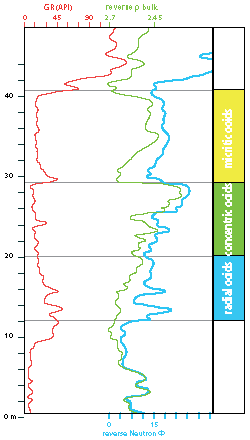
Click on thumbnail to enlarge the image.
Figure 1: Log of a Fontaine-au-Bron field (modified from the Geopetrol website) documenting the three fold division of the Dalle Nacrée into a basal radial ooid unit, a median concentric ooid unit and a upper micritic ooid unit.
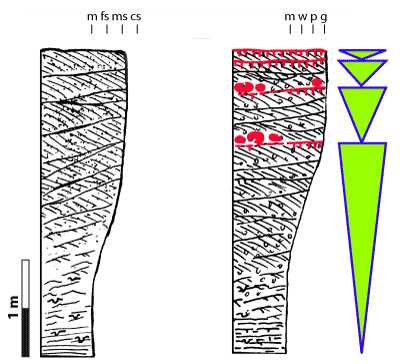
Click on thumbnail to enlarge the image.
Figure 2: Comparison of a siliciclastic parasequence (left) and a carbonate parasequence (right). The carbonate parasequence can be divided into 4 "pseudo-parasequences" on the basis of the occurrence of early diagenetic discontinuities (hardgrounds and derived intraclasts) as indicated in red.
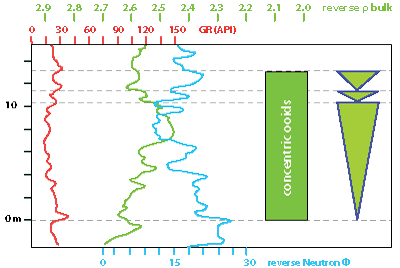
Click on thumbnail to enlarge the image.
Figure 3: Example of a well log illustrating a single carbonate parasequence (unit with concentric ooids) divided into 3 "pseudo-parasequences" (well "T", field "T", east of Paris).
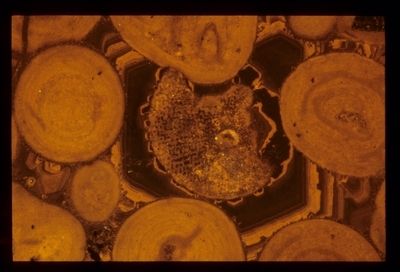
![]()
Click on thumbnail to enlarge the image.
Figure 4:
Syntaxial cement overgrowths on an echinoderm fragment (possibly an echinoid
spine) with
a monocrystalline behavior [they
are not monocrystalline, but behave as if they were]. This bioclast was eroded,
possibly bio-eroded, but discrete rates of cementation on the monocrystal faces
"quickly" masked the corroded surface. This phenomenon is poorly
developed during the early phases represented here by the succession of brown, orange,
dark brown to black (non-luminescent) phases of cementation, but better
illustrated in the next alternating phases, brown zoned and orange zoned. Note the very small quantity of cement on allochems other than echinoid
fragments (mainly ooids).
(Ref.: 4.15X5) (well "S", field "S", east of Paris)
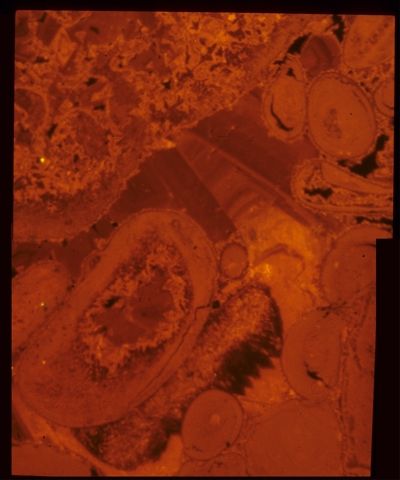
![]()
Click on thumbnail to enlarge the image.
Figure 5:
Syntaxial cement overgrowth on an echinoderm fragment acting as a single crystal
: 1)
early phases of cementation (synsedimentary diagenesis) of which only the last
phase, dark brown to black (non-luminescent), is clearly identifiable; 2)
intermediate phases of cementation characterized by a predominance of orange
color, with some thin zones having brownish tones. Two of these darker colored
bands provide a remarkably good marker; 3)
late phases of cementation are predominantly brown, with more or less diffuse
zonation.
(Ref.: 205828X5) (well "X", field "X", east of Paris)
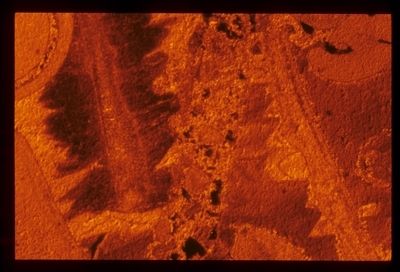
![]()
Click on thumbnail to enlarge the image.
Figure 6:
Syntaxial cement overgrowths on echinoderm fragments with
a monocrystalline behavior. The fragment on the right was micritized: this envelope, in part organic, prevented locally the
development of the early phases of cementation represented by a dark brown to
black phase (not-luminescent) around it. However, this phase is visible around the
second fragment, the one on the left.
(Ref.: 205828X10) (well "X", field "X", east of Paris)
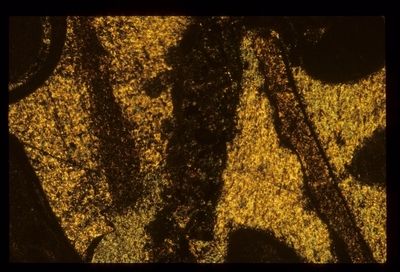
![]()
Click on thumbnail to enlarge the image.
Figure 7:
The preceding figure viewed under conventional transmitted light.
(Ref.: 205828X10) (well "X", field "X", east of Paris)
With the exception of this figure, all microscopic views were produced
by cathodoluminescence.
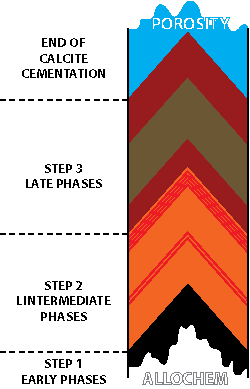
Click on thumbnail to enlarge the image.
Figure 8: Diagenetic log (stratigraphic succession of the phases of cementation) used to establish the paragenetic sequence.
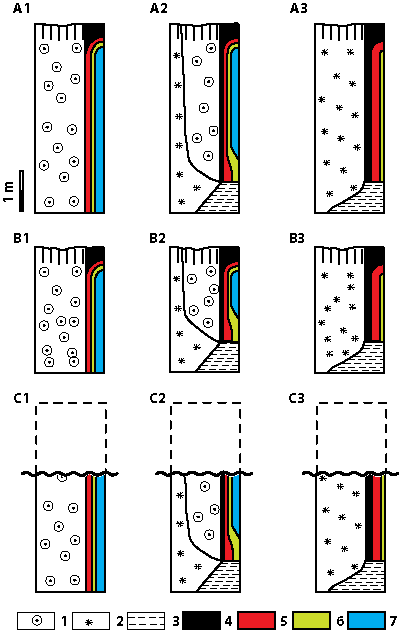
Click on thumbnail to enlarge the image.
Figure 9: Examples of A) expanded pseudo-parasequences, B) shortened pseudo-parasequences, and C) eroded pseudo-parasequences. For each row, column 1) is an oolitic facies, 2) a mixed oobioclastic facies and 3) a bioclastic facies. The resulting distribution of cements and residual porosity is indicated by the colored stripes. Key: 1- ooids, 2- bioclasts, 3- marl, 4- early cements, 5- intermediate and late calcitic cements, 6- dolomitic cements, 7- residual porosity.
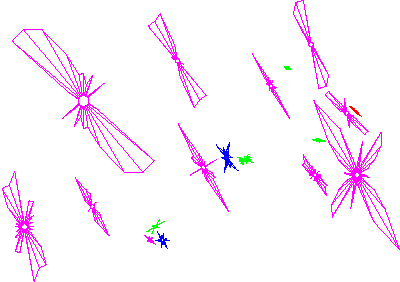
Click on thumbnail to enlarge the image.
Figure 10: Rose diagrams of the tectonic planes in a number of wells from field "X" (east of Paris) scaled with respect to fracture frequency. Key: open fractures (pink), calcite-filled fractures (blue), striated fractures - slickensides - (red), and tectonic stylolites (green). Well locations of this set have been modified to honor confidentiality of the data.
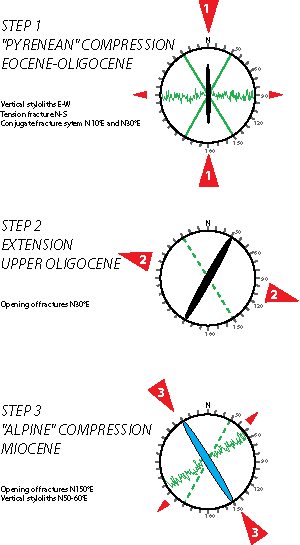
Click on thumbnail to enlarge the image.
Figure 11: Chronology of deformation during the Cenozoic era that affected mid-Jurassic strata in the Paris basin, summarized here as a succession of three phases of tectonism (with red arrows indicating the orientation of the maximum stresses).
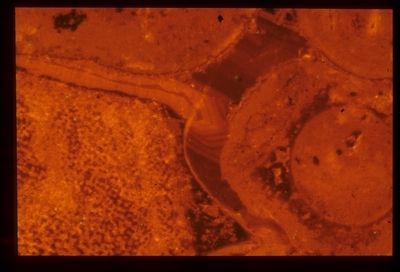
![]()
Click on thumbnail to enlarge the image.
Figure 12:
Fragment of the cortex of an ooid with: on its outer side, a thin fringing cement the last phase of which is orange
(intermediate) and
on its inner side, an orange poecilitic cement (also intermediate) in which the
two marker brown zones are recognizable.
(Ref.: 205440X10) (well "X", field "X", east of Paris)
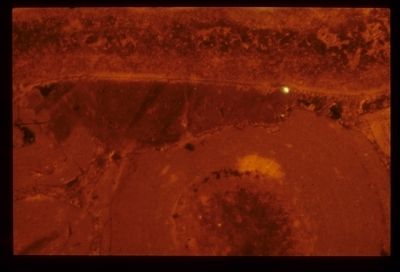
![]()
Click on thumbnail to enlarge the image.
Figure 13:
Pressure-solution type contact between an ooid and a poecilitic cement
dominantly brown in color (late phase of cementation).
(Ref.: 205440X10) (well "X", field "X", east of Paris)
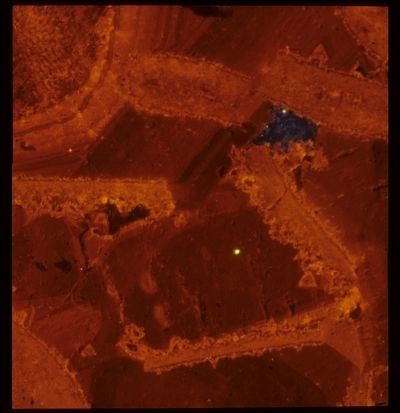
![]()
Click on thumbnail to enlarge the image.
Figure 14:
Bioclast bounded by predominantly brown poecilitic crystals (late phase of
cementation).
(Ref.: 205440X10) (well "X", field "X", east of Paris)
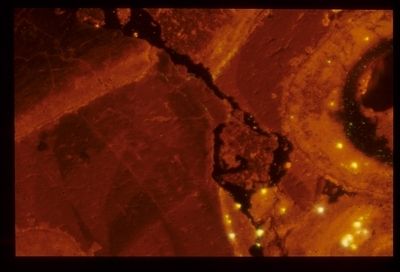
![]()
Click on thumbnail to enlarge the image.
Figure 15:
Tectonic stylolites cutting predominantly brown (late phase of cementation)
poecilitic cements.
(Ref.: 205610X10) (well "X", field "X", east of Paris)
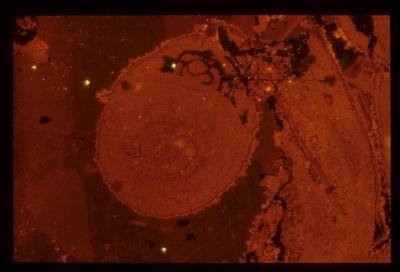
![]()
Click on thumbnail to enlarge the image.
Figure 16:
Tectonic stylolites cutting predominantly brown (late phase of cementation)
poecilitic cements.
(Ref.: 205670X10) (well "X", field "X", east of Paris)

![]()
Click on thumbnail to enlarge the image.
Figure 17:
Tectonic stylolites cutting predominantly brown (late phase of cementation)
poecilitic cements.
(Ref.: 206280X10) (well "X", field "X", east of Paris)
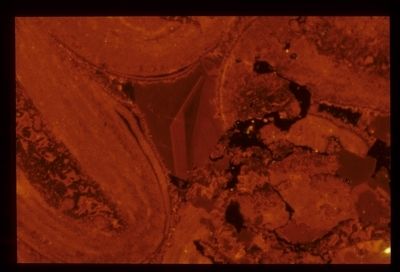
![]()
Click on thumbnail to enlarge the image.
Figure 18:
Tectonic stylolites cutting predominantly brown (late phase of cementation)
poecilitic cements.
(Ref.: 205850X10) (well "X", field "X", east of Paris)
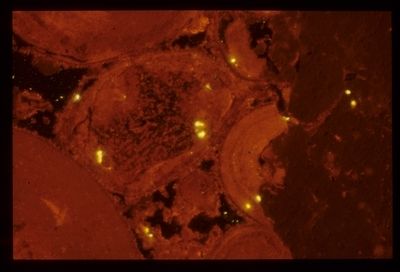
![]()
Click on thumbnail to enlarge the image.
Figure 19:
Calcite "veins" filled by predominantly brown (late phase of
cementation) poecilitic cements.
(Ref.: 205540X10) (well "X", field "X", east of Paris)
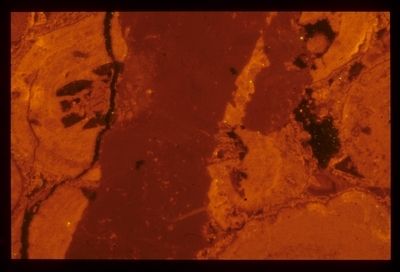
![]()
Click on thumbnail to enlarge the image.
Figure 20:
Calcite "veins" filled by predominantly brown (late phase of
cementation) poecilitic cements.
(Ref.: 205640X10) (well "X", field "X", east of Paris)
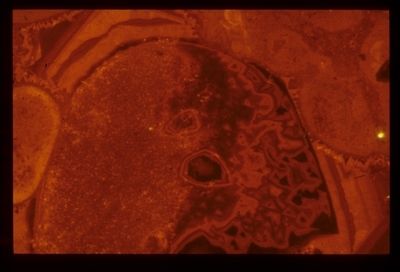
![]()
Click on thumbnail to enlarge the image.
Figure 21:
Brown, light brown, orange, brown zoned and black (non-luminescent),
cauliflower-like, early phases of cementation, followed by intermediate phases: orange zoned with
light brown.
(Ref.: 185795X10) (well "X", field "X", east of Paris)
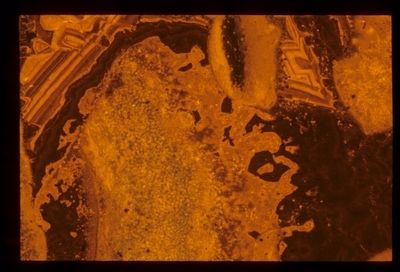
![]()
Click on thumbnail to enlarge the image.
Figure 22:
Yellow and dark brown to black (non-luminescent), cauliflower-like, early phases of
cementation, followed by intermediate phases with almost linear zone
boundaries: light brown zoned with orange.
(Ref.: 2.00X5) (well "S", field "S", east of Paris)
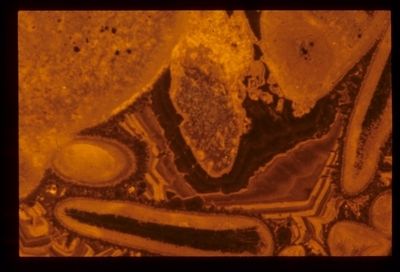
![]()
Click on thumbnail to enlarge the image.
Figure 23:
Thin yellow, thick dark brown to black (non-luminescent), cauliflower-like, early
phases of cementation, followed by intermediate phases with almost linear zone
boundaries: light brown zoned with orange and brown zoned with dark brown.
(Ref.: 2.30x5) (well "S", field "S", east of Paris)
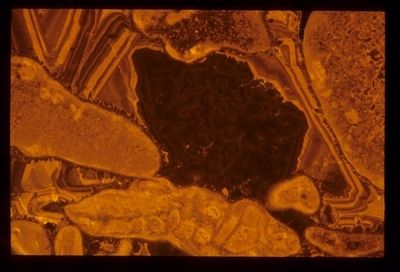
![]()
Click on thumbnail to enlarge the image.
Figure 24:
Dark brown to black (non-luminescent), cauliflower-like, early phase of
cementation, followed by intermediate phases with almost linear zone
boundaries: light brown zoned with orange and brown zoned with dark brown.
(Ref.: 2.17X5) (well "S", field "S", east of Paris)
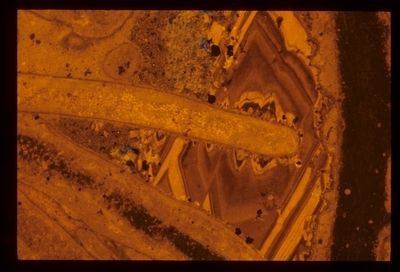
![]()
Click on thumbnail to enlarge the image.
Figure 25:
The zones in the rim cement of the echinoderm fragment have a zig-zag outline due to
an irregular, interrupted micritic encrustation of the echinoderm remain. The following succession is:
dark brown to black (non-luminescent), orange zoned with brown, brown to light brown
that represent discrete phases of cementation.
(Ref.: 8.16x5) (well "S", field "S", east of Paris)
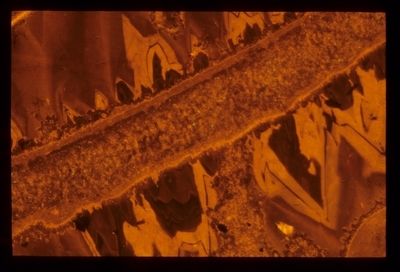
![]()
Click on thumbnail to enlarge the image.
Figure 26:
The zones in the rim cement of the echinoderm fragment have a zig-zag outline due to an
irregular, interrupted micritic encrustation of the echinoderm remain. The following succession is:
dark brown to black (non-luminescent), orange zoned with brown, brown to light brown
that represent discrete phases of cementation.
(Ref.: 2.06x10) (well "S", field "S", east of Paris)
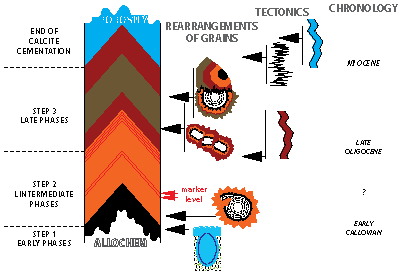
Click on thumbnail to enlarge the image.
Figure 27: Dating of a paragenetic sequence using the successive phases of cementation over time, cementation as related to grain rearrangement, and the development of tectonic fractures and stylolites.